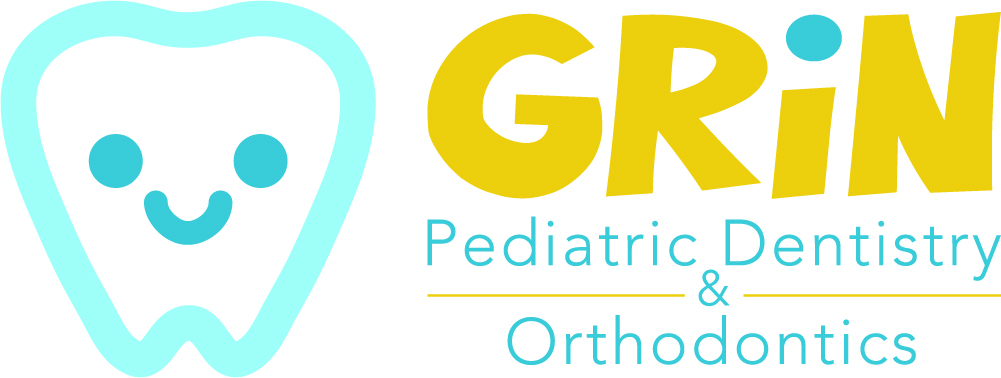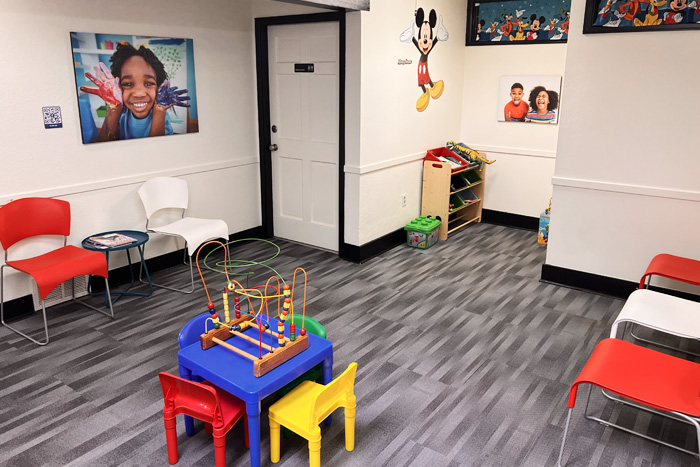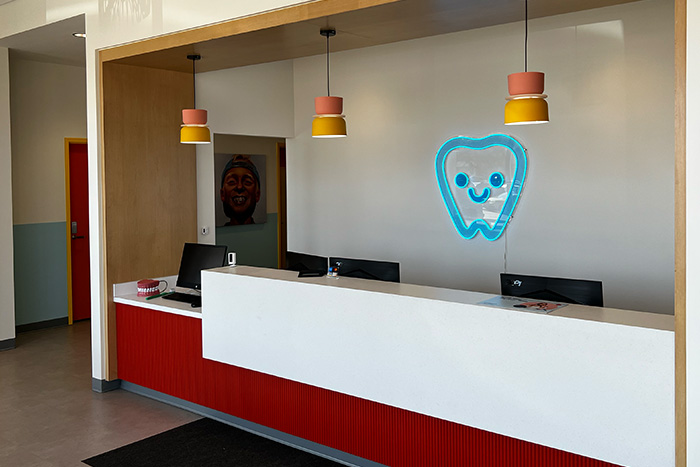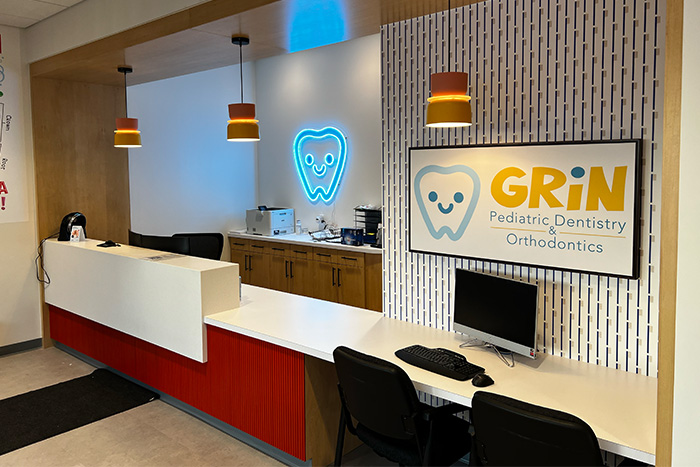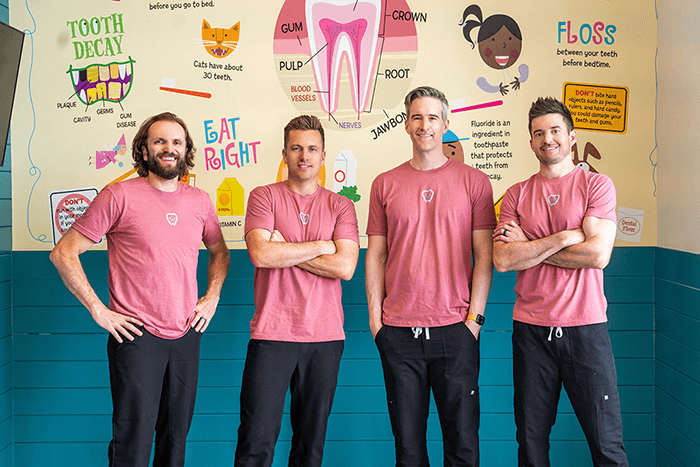Are Baby Teeth Important?
Baby teeth are more important than most people realize. Even though they’re temporary, they play a big role in your child’s overall health and development. Baby teeth, or first teeth, usually start coming in around six months, and by age three, most children have a full set of 20. These small teeth are essential for helping your child grow, develop, and maintain good oral health.
In this article, we’ll explain why baby teeth matter, how they impact future dental health, and share tips for taking care of them.
Why Are Baby Teeth So Important?
Tiny, but mighty — that’s how dentists think of baby teeth. You might just see cute smiles and giggles when you look at them, but those teeth have serious work to do:
- Saving Space for Permanent Teeth: Baby teeth help guide permanent teeth into the right position. When one is lost too early, it can cause the nearby teeth to shift, making it harder for the adult teeth to grow in properly.
- Speech Development: Believe it or not, baby teeth are crucial for your child’s ability to form sounds and speak clearly.
- Chewing and Nutrition: Without healthy baby teeth, it’s harder for your child to chew food properly. And we all know that proper nutrition is key to their growth and development.
- Self-Esteem: Having a healthy smile helps kids feel good about themselves. When baby teeth are neglected, it can lead to pain, embarrassment, or discomfort — all things we want to help our little ones avoid.
- Preventing Infection: Cavities in baby teeth aren’t just painful; they can lead to more serious infections. If decay isn’t treated, it could spread and even affect the underlying adult teeth.
Key Reasons Baby Teeth Are Essential for Your Child’s Development
Caring for your child’s baby teeth is important now and helps ensure they have healthy teeth for life. Here are a few key reasons why baby teeth are essential for your child’s overall development:
- They Help Form Your Child’s Face and Jaw: Baby teeth actually help shape your child’s face! When they’re lost prematurely, it can affect the way their facial muscles and bones develop.
- Building Confidence Early: A healthy smile is a confident smile, and we all want our kids to feel good about themselves. If their teeth are healthy, it’s one less thing for them to worry about, and it can help build confidence in their interactions with others.
- Preventing Future Problems: Caring for baby teeth also helps protect the adult teeth developing underneath. Infections or decay in baby teeth can cause problems for the adult teeth as they grow in.
How Baby Teeth Impact Future Dental Health
The state of your child’s baby teeth can have a lasting impact on their dental health as they grow. Here’s why:
- They Act as Guides for Permanent Teeth: Baby teeth hold space for adult teeth. If a baby tooth is lost too early, it can cause crowding or crooked adult teeth.gnment issues, leading to crowding or crooked teeth when the adult teeth come in.
- Preventing Big Issues Later: Letting cavities or other dental issues go untreated in baby teeth can cause problems down the road. For instance, severe decay can lead to infections that might damage the adult teeth beneath.
- Setting the Stage for Healthy Habits: Teaching kids to care for their baby teeth helps build lifelong dental habits. Starting with good brushing, flossing, and regular dentist visits early will protect their adult teeth in the future.
Tips for Taking Care of Your Baby’s First Teeth
When it comes to baby teeth, a little care goes a long way. Here are some tips to help you keep your child’s teeth healthy:
- Start Early: Even before your baby’s teeth come in, you can gently clean their gums with a damp cloth. Once that first tooth appears, it’s time to start brushing with a small, soft-bristled toothbrush and a tiny bit of fluoride toothpaste.
- Fluoride is Your Friend: Using a little fluoride toothpaste helps to strengthen your child’s enamel and protect against cavities. For babies and toddlers, a tiny amount is all you need — about the size of a grain of rice.
- Limit Sugary Snacks and Drinks: Sugar is a major culprit when it comes to cavities. Try to limit sugary snacks and drinks like juice, especially before bed.
- Establish a Routine: Make brushing and flossing a fun, regular part of your child’s daily routine. Even if your child resists at first, sticking to the routine will help make these healthy habits a lifelong part of their day.
- Visit the Dentist Early: You should take your child to the dentist by their first birthday or within six months after their first tooth appears. This might seem early, but it helps your child get used to dental visits and allows the dentist to catch any early signs of problems.
Will Baby Teeth Affect Permanent Teeth?
Absolutely! Baby teeth are critical for the proper alignment and health of permanent teeth. Here’s how:
- Guiding the Way: Baby teeth act as placeholders for permanent teeth, helping them come in properly aligned. Losing a baby tooth too early can cause the surrounding teeth to shift, leading to crowded or crooked adult teeth.
- Impacting Future Orthodontics: If baby teeth aren’t taken care of, the resulting issues (like crowding or misalignment) can lead to the need for orthodontic treatments, such as braces, down the road.
- Healthy Baby Teeth = Healthy Adult Teeth: Decay or infections in baby teeth can also affect the adult teeth underneath. Keeping baby teeth healthy helps ensure that your child’s adult teeth come in strong and healthy.
When to Visit the Dentist for Your Baby’s First Dental Checkup
One of the most common questions we hear from parents is: “When should my child visit the dentist for the first time?” The answer is simple — your child should visit the dentist by their first birthday or within six months of getting their first tooth. Early dental visits are important for a number of reasons:
- Preventing Cavities: The dentist will check for early signs of decay and offer tips on how to prevent cavities before they start.
- Monitoring Development: The dentist will also keep an eye on how your child’s teeth are coming in and make sure everything is developing as it should.
- Comfort with the Dentist: Starting dental visits early helps your child feel more comfortable with the dentist, reducing dental anxiety about dental appointments as they grow older.
How Pediatric Dentistry Helps Your Child
Pediatric dentistry ensures your child’s teeth stay healthy from the start. It focuses on the specific needs of infants, toddlers, and children, offering gentle care to build strong oral health habits. Pediatric dentists make visits comfortable and stress-free, helping reduce anxiety and creating positive experiences.
From regular checkups to more advanced treatments, pediatric dentistry cares for your child’s baby teeth and future permanent teeth. Early visits help prevent problems like cavities and misalignment while teaching kids how to care for their teeth.
Partnering with a pediatric dentist sets your child up for a lifetime of healthy smiles. For expert, gentle care in a fun and comfortable setting, schedule a visit with Grin Pediatric Dentistry and Orthodontics today!
How to Brush Baby Teeth
Learn About Brushing Your Child or Toddlers Teeth in Lakewood, CO.
Helping your children create positive oral health habits will help them have a lifetime of healthy teeth. But if you’re wondering when do I start brushing my child’s teeth and how do I do brush them effectively—you’re not alone. At Grin Pediatric Dentistry and Orthodontics, we understand that brushing your child’s teeth can be challenging so we’ve created these tips on brushing baby teeth.
When Should I Start Brushing My Child’s Teeth?
- No baby teeth: Clean your baby’s mouth and gums with a soft, damp cloth. You can also help minimize the bacteria and sugar your child consumes by never dipping pacifiers in anything sweet and by not cleaning the pacifier with your own mouth.
- First baby tooth erupts: Begin using a small-headed, soft-bristled toothbrush to brush your child’s teeth.
- Baby teeth ages under 3: Apply a small amount of toothpaste (about the size of a grain of rice) and gently brush in a circular motion on the teeth and gums, for two minutes.
- Baby teeth ages 3+: Apply a pea-sized amount of fluoride toothpaste before brushing in tiny circles for two minutes. After brushing, have your child spit out any excess toothpaste.
We recommend that you brush twice a day (morning and before bedtime), start flossing as soon as your child has two teeth that are touching, and change to a new toothbrush every 3-4 months.
Make Brushing Fun
Help create positive brushing experiences by making the overall experience more fun for your child.
- Let them pick out a soft-bristled, child-sized toothbrush that they love.
- Bring a favorite toy in while brushing and let your child practice brushing the toy’s teeth (with just the toothbrush, no toothpaste).
- Take turns brushing your child’s teeth. If you start brushing, after one minute, let them try brushing either with your help or on their own. This will help them feel more involved and confident about brushing on their own when they get to that stage.
- Play a fun song that lasts about two minutes. This helps them understand how long they will have to brush and that once the song is over, it’s time to rinse.
- Give praise after brushing. Help encourage your child and create positive experiences by praising your child after each brushing.
Summary
Grin Pediatric Dentistry and Orthodontics is committed to keeping even the smallest smiles in Lakewood, CO as healthy as they can be. Our pediatric dentists can help educate parents and children so everyone feels confident knowing when to start brushing baby teeth, how to brush effectively, and how to make brushing teeth a fun activity. Schedule your child’s next check-up or call our office with any questions.
Call Grin Pediatric Dentistry and OrthodonticsPediatric Dental Sealants
Wondering About Your Child’s Dental Sealants at Grin Dentistry and Orthodontics?
Pediatric dental sealants are an important preventive measure designed to give your child’s smile every possible advantage. Many dentists recommend children get sealants on their teeth as soon as their permanent molars grow in to prevent decay from the beginning. It is essential to protect your child’s oral health early on and prevent problems that may trouble them later on.
What Are Pediatric Dental Sealants?
The “grooves,” or crevices and pits along the back molars are highly susceptible to germs and bacteria that build up when food particles, such as sugar, become trapped inside them. Regular brushing goes a long way, but even the most dedicated of brushers can struggle to clean those grooves properly.
A pediatric dental sealant is a thin white or clear resin liquid applied to the surface of a child’s molars with a small brush. This thin coating placed over the biting surface of the molars protects them from decay. The protective coating reduces a child’s risk of cavities by 80% according to the American Dental Association (ADA).
Are Pediatric Dental Sealants Safe?
Dental sealants are safe and pose minimal risk to children. They are a great non-invasive way to help protect your child’s teeth from cavities. No materials go inside the tooth as fillings do. Sealants are made of a medical-grade resin. The materials are similar to the white filling material used when patients have cavities filled. The main difference is the sealant material; it’s runny in nature. Sealants are applied to teeth using a small brush to easily flow into the micro-grooves of the teeth.
The Procedure
This non-invasive and painless procedure is quick and completed in one visit. The procedure starts by cleaning the teeth being sealed with a polishing brush and pumice (gritty toothpaste). Once the teeth have been dried, they are isolated from any saliva from the tongue and cheeks using a small cotton roll or triangular intraoral cheek shield called a “dry angle.” Then, an etching solution is applied to the surface of the teeth to disinfect and prep the tooth for better sealant adherence. The teeth are rinsed off and dried once again. A thin bonding layer is painted on the teeth, then the sealant is applied directly onto the surface of the teeth, covering the enamel. After that is complete, the teeth are “cured” or dried using an LED blue light. This allows for faster application because it hardens and bonds the sealant to the tooth surface.
This entire process only takes about one minute for each tooth needing to be sealed. There are also no restrictions following the procedure, patients can eat and drink right away and can return to school immediately after. Dental sealants for a child are designed to protect their teeth for a minimum of 3-5 years, with a maximum of 10 years if they are well maintained. During your child’s regular dental checkups, the dentist will check the sealants to ensure they are still in place and haven’t cracked or worn away. If they do get damaged, they can be easily repaired.
Learn More About Pediatric Dental Sealants at Grin Pediatric Dentistry and OrthodonticsPediatric Dental Fillings
Worried About Your Child Getting Fillings at Grin Dentistry and Orthodontics?
It can be distressing to learn from your child’s dentist that your child has a cavity in one of their teeth. If cavities are left untreated, it leads to negative consequences for both the children and parents. Luckily, a pediatric dentist can keep your kid’s teeth healthy. At Grin Pediatric Dentistry and Orthodontics, we offer pediatric dental fillings and sealants to help prevent and stop the spread of cavities in kids.
What Is a Cavity?
A cavity is a hole in the tooth caused by bacteria that produce acids, which eat away at the enamel. Cavities form when sugars and starches from food mix with bacteria, creating acid that weakens the enamel. At first, a cavity may be small, but if left untreated, it can grow and cause more damage. Cavities commonly form on the chewing surfaces of molars or between teeth, where food often gets trapped.
What Causes Cavities in Kids?
Understanding what causes cavities in kids can help you take steps to prevent them. Here are some of the most common reasons children get cavities:
- Not Brushing and Flossing Enough: When kids don’t brush and floss regularly, plaque (a sticky layer of bacteria) forms on their teeth. This plaque produces acid that damages tooth enamel, causing cavities.
- Eating Too Many Sugary Snacks and Drinks: Foods such as soda, milk, candy, cake, raisins, fruit juices, bread, and cereals can be the culprit for tooth decay. The bacteria that live in the mouth change these foods into acids. The combination of food, bacteria, saliva, and acid form plaque that sticks to the teeth. Over time, the acids made by the bacteria will eventually cause cavities..
- Frequent Snacking: If your child is constantly snacking or drinking sugary beverages throughout the day, their teeth are under frequent acid attacks, increasing the chance of cavities.
- Not Enough Fluoride: Fluoride strengthens tooth enamel and helps prevent cavities. Children who don’t use fluoride toothpaste or drink fluoridated water may be more likely to develop tooth decay.
- Dry Mouth: Saliva helps wash away food particles and neutralize acids in the mouth. If your child has dry mouth, it can increase the risk of cavities because there’s less saliva to protect their teeth.
- Tooth Decay –The breakdown of tooth enamel is called tooth decay. Tooth decay can eventually lead to cavities (holes in the teeth). Tooth decay is caused by bacteria and occurs when foods that contain carbohydrates are left on the teeth.
Types of Dental Fillings for Kids
When your child has a cavity, a dental filling is used to repair the tooth. There are different types of dental fillings for children, and the right one for your child depends on factors like the size and location of the cavity.
- Composite Fillings (Tooth-Colored Fillings): These fillings are made from plastic and glass and can be matched to your child’s tooth color, making them less noticeable. They’re a popular choice for front teeth where appearance matters.
- Amalgam Fillings (Silver Fillings): Amalgam fillings are made from a blend of metals, including silver and mercury. They’re very durable and strong, which makes them a good choice for cavities in the back teeth where more chewing takes place. However, they’re more noticeable than composite fillings due to their silver color.
- Glass Ionomer Fillings: These are made from a mix of glass and acrylic and are often used for small cavities in baby teeth. Glass ionomer fillings release fluoride over time, which can help protect the tooth from further decay. They’re not as strong as other types, so they’re usually used for smaller cavities.
- Ceramic Fillings: Ceramic fillings are made from porcelain and are very durable. They’re also resistant to staining and can be matched to the tooth’s color. These fillings are often used for larger cavities or in teeth that need extra strength, like molars.
Your dentist will recommend the best type of filling for your child based on their needs and the location of the cavity.
How Do Dentists Fill Cavities in Toddlers and Children?
Getting a cavity filled may seem like a big deal to your child, but it’s a routine procedure that’s made as simple and comfortable as possible. Here’s how dentists fill cavities in toddlers and children:
- Numbing the Tooth: The dentist will start by numbing the area around the cavity to ensure your child feels no pain during the procedure. They may use a topical anesthetic before the injection to make your child more comfortable.
- Removing the Decay: Once the tooth is numb, the dentist will gently remove the decayed part of the tooth using special tools. This step is important to stop the cavity from getting worse and to make space for the filling.
- Cleaning the Tooth: After the decay is removed, the dentist will clean the area to make sure no bacteria are left behind.
- Placing the Filling: The filling material is then placed in the cavity to restore the tooth. For composite fillings, a special light may be used to harden the material quickly. Amalgam fillings don’t require light and are shaped to fit the tooth.
- Final Adjustments: Once the filling is in place, the dentist will adjust it to ensure it fits comfortably in your child’s mouth and doesn’t interfere with their bite.
After the procedure, your child may feel some numbness or mild sensitivity, but this should go away within a few hours.
Tips for Preparing a Child for Cavity Filling
Dental visits can sometimes make kids nervous, especially if they’re getting a filling. Here are some tips for preparing your child for a cavity filling to help make the experience easier for them:
- Explain the Procedure in Simple Terms: Use language your child will understand. You can tell them the dentist is going to “clean out the sugar bugs” and “give their tooth a special bandage” to make it feel better.
- Stay Positive and Calm: Kids pick up on their parents’ emotions, so staying calm and positive about the dentist visit can help reassure them that everything will be fine.
- Read Books or Watch Videos: Many children’s books and videos explain dental visits and fillings in a fun and friendly way. Watching these together can help your child feel more comfortable.
- Practice Relaxation: If your child is feeling anxious, practicing deep breathing or visualizing a happy place can help them relax before the appointment.
- Reward Them Afterward: Offer a small reward, like a sticker or a fun outing, for being brave at the dentist. Positive reinforcement can make the experience more enjoyable for them.
Choose the Right Dentist
Choosing the right dentist for your child is important when it comes to making dental visits a positive experience. A pediatric dentist specializes in caring for children’s teeth and knows how to create a welcoming, comfortable environment.
Here’s why it’s important to choose the right dentist for your child:
- Experience with Kids: Pediatric dentists are specially trained to work with children and know how to make them feel comfortable during dental procedures. They use gentle techniques and fun, kid-friendly language to explain what’s happening.
- Comprehensive Care: Look for a dentist who offers a wide range of services, from routine checkups to fillings and other treatments. This ensures your child will receive the care they need as they grow.
- Kid-Friendly Environment: Many pediatric dental offices are designed with kids in mind, with bright, fun decor and toys to keep your child entertained and comfortable during their visit.
- At Grin Pediatric Dentistry and Orthodontics, We provide gentle, caring dental services for kids of all ages. Our goal is to make each visit fun and stress-free, helping your child feel comfortable while keeping their smile healthy. With five locations in Colorado—Denver, Centennial, Northglenn, Lakewood, and Aurora—our team is here to support your child’s dental health every step of the way.
Dental fillings are one of the simplest dental procedures. If your child properly cares for his or her dental fillings by brushing twice a day, flossing daily, and visiting their dentist every 6 months for a checkup, their fillings could last for years.
At Grin Pediatric Dentistry and Orthodontics, We provide gentle, caring dental services for kids of all ages. Our goal is to make each visit fun and stress-free, helping your child feel comfortable while keeping their smile healthy. With five locations in Colorado—Denver, Centennial, Northglenn, Lakewood, and Aurora—our team is here to support your child’s dental health every step of the way.
Call Grin Pediatric Dentistry and OrthodonticsnLearn More About Fillings
